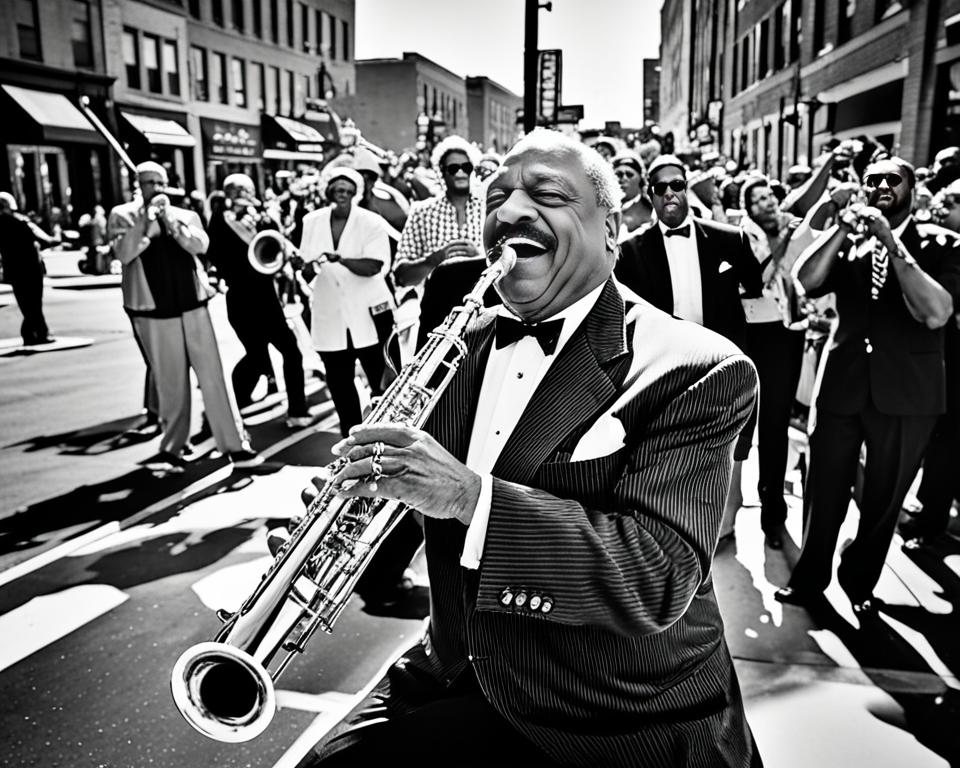music and a pioneering force in jazz history as a bandleader and pianist.">
Count Basie: The Legendary Jazz Pianist and Bandleader
Did you know Count Basie was a major jazz star for six decades? Born William James Basie, he left a huge mark. He rocked the jazz world as a pianist, organist, bandleader, and composer. From 1924 to 1984, his work changed music.
He led the Count Basie Orchestra for 50 years. Their swing music is still loved today. Basie was known for his unique band setup and strong beat.
The band’s riffing style made them stand out in jazz. With Basie, stars like Lester Young and singers like Joe Williams became famous. To learn more about how Basie changed jazz, dive into his story.
Early Life and Musical Influences
Count Basie, also known as William James Basie, grew up in Red Bank, New Jersey. This town was crucial to his early music experiences. The local music scene there greatly influenced his career path.
Childhood in Red Bank, New Jersey
William Basie’s childhood was filled with music in Red Bank. He was surrounded by a rich musical culture. The Palace Theater was a place where he soaked up many styles and refined his improvisational skills.
Influence of Parents on Basie’s Musical Journey
Basie’s mom and dad, Lillian and Harvey Lee Basie, played a big role in his musical growth. They both had musical backgrounds and pushed William toward music. His mom, Lillian, was especially impactful, giving him piano lessons and financial support for his training. Their efforts gave him a strong musical foundation.
First Piano Lessons and Initial Training
Basie’s journey into music started with piano lessons from his mom. His training was strict and thorough. He quickly mastered stride piano, known for its rhythm and complexity. Meeting drummer Sonny Greer, who worked with Duke Ellington, also motivated him to stick with the piano. This decision led him to a historic career in jazz.
The Kansas City Jazz Scene
Count Basie’s career changed forever in Kansas City. He first mixed with famous jazz stars in Harlem. People like Willie “the Lion” Smith and Fats Waller were his circle. Then, he moved to Kansas City. That’s where his unique style developed, making a big impact on jazz.
Joining Bennie Moten’s band was a game-changer for Basie. This group was known for its rhythmic conception and special arrangements. They played the Kansas City stomp style. This was different from the more bluesy music of bands like the Blue Devils.

After Bennie Moten died, Basie took over. He formed the Count Basie Orchestra. His time in Kansas City influenced its music. The band became famous for its rhythm and swing. This style was new and exciting.
Basie worked with other Kansas City jazz legends too, like the Barons of Rhythm. His achievements in Kansas City set him up for future success. His work left a lasting impact on jazz music.
Formation of the Count Basie Orchestra
The formation of the Count Basie Orchestra was a key moment in jazz. It brought together top talents from Walter Page’s Blue Devils and Bennie Moten’s band. This group sparked a new wave of jazz innovation.
From Walter Page’s Blue Devils to Count Basie’s Band
Count Basie took his experience from Walter Page’s Blue Devils and Bennie Moten’s band to start his own. His band continued the great big band traditions and skills. It was built on a strong base of experience and talented musicians.
Signature Style and Innovations
The Count Basie Orchestra was known for its jazz breakthroughs. They were famous for using dual tenor saxophones, creating a lively “duel” in their music. They focused on strong rhythms, making a unique sound.
One of their big hits was “One O’Clock Jump.” It was made during a late-night radio show. This song shows Basie’s creative approach to jazz. It’s a key piece of the band’s legacy.
“One O’Clock Jump” highlights Count Basie’s jazz style: spontaneous, rhythmic, and always new. The Count Basie Orchestra always pushed jazz and big band music forward.
The Count Basie Orchestra, under Basie’s leadership, was a force in jazz. This group set the bar high for jazz bands that followed.
Count Basie’s Rise to Fame
Count Basie quickly became a star in the jazz world, thanks to John Hammond. Hammond found Basie in 1936 during a radio show in Kansas City. He saw Basie’s talent and helped him make his first records, bringing him national fame.
The Role of John Hammond
John Hammond made a big difference for Basie and his band. He introduced them to big audiences and record companies. Thanks to Hammond, Basie’s early music reached jazz fans everywhere. This partnership gave the band chances to record, inspiring them to try new sounds and making Basie a jazz legend.
First Recordings and Major Hits
Basie’s hit “One O’Clock Jump” showed his band’s lively style and swing. This track and others like “Jumpin’ at the Woodside” and “Taxi War Dance” became very popular. Basie’s piano playing was simple but full of rhythm and feeling. These songs won over fans in the Swing Era, making his mark in jazz history.


